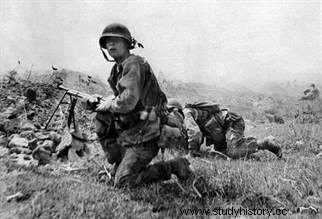 The Battle of Diên Biên Phu opposed in 1954 the French army and the Vietnamese communist forces of the Viêt-minh in the steep-sided plain of Diên Biên Phu, located in the northwest of Vietnam, near the border with Laos. This battle, from which the Viet Minh emerged victorious, marked the end of the Indochina War (1946-1954), but also that of French hegemony in this region. It resulted, during the Geneva Accords, in the partition of Vietnam into two distinct states. This defeat will leave a lasting mark on the French army and will cause great trauma for the survivors of this battle.
The Battle of Diên Biên Phu opposed in 1954 the French army and the Vietnamese communist forces of the Viêt-minh in the steep-sided plain of Diên Biên Phu, located in the northwest of Vietnam, near the border with Laos. This battle, from which the Viet Minh emerged victorious, marked the end of the Indochina War (1946-1954), but also that of French hegemony in this region. It resulted, during the Geneva Accords, in the partition of Vietnam into two distinct states. This defeat will leave a lasting mark on the French army and will cause great trauma for the survivors of this battle.
The context of the Indochina War
Since the second half of the 19th century, the French have been present in a large part of the Indochinese peninsula, in Southeast Asia. Their Indochina colony includes Tonkin, Annam, and Cochinchina (three regions that make up present-day Vietnam), Laos, and Cambodia.
At the end of the Second World War, the nationalists, members of the Viêt-minh, the Indochinese Communist Party, demanded the departure of the French and the independence of French Indochina. They refuse to maintain the French colonial occupation, because of the attitude of the Vichy government during the war and the important role played by the nationalists in the liberation of their country invaded by the Japanese from July 1941. On the initiative of their leader Ho Chi Minh, they proclaimed the independence of the "democratic republic of Vietnam" on September 2, 1945, the day of the official surrender of Japan and, therefore, the end of the Second World War.
France sends two emissaries, Jean Sainteny and General Leclerc, to discuss with Ho Chi Minh the future of the French colony. It intends to maintain it in the French Union, despite a status of autonomy which only "associates" it with France without giving it its independence. The nationalists deemed this solution unacceptable and, in November 1946, the Indochina War broke out.
Operation "Castor", prelude to the battle of Diên Biên Phu
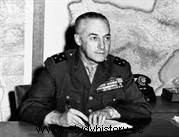 The siege of Diên Biên Phu, in the spring of 1954, corresponds to the last phase of this war which has lasted almost eight years. On November 20, 1953, General Henri Navarre, who had succeeded General Raoul Salan six months earlier at the head of the French expeditionary force, was given the task of opposing the extension of the Viet Minh's activities to the west. Tonkin and Annam, that is to say in Laos. It is an independent state but a member of the French Union, whose sovereign is in favor of maintaining France in the region.
The siege of Diên Biên Phu, in the spring of 1954, corresponds to the last phase of this war which has lasted almost eight years. On November 20, 1953, General Henri Navarre, who had succeeded General Raoul Salan six months earlier at the head of the French expeditionary force, was given the task of opposing the extension of the Viet Minh's activities to the west. Tonkin and Annam, that is to say in Laos. It is an independent state but a member of the French Union, whose sovereign is in favor of maintaining France in the region.
As part of Operation Castor, two airborne groups were parachuted on November 20 in the heights of Tonkin, near the border with Laos, on a former chief- administrative place of the name of "Diên Biên Phu". The initial objective is then to retake the sector to prevent the advance of General Giap's troops. To protect the road from Luang-Prabang, the French set up an entrenched camp, placed in a basin measuring 16 by 9 kilometers. reinforcements.
Engineers prepare the ground so that they can spot enemy artillery and attack Viet Minh fighters from this base. Under the orders of Colonel Christian de Castries, more than 4,500 men set up a whole security system with barbed wire, trenches, forts, etc., and restored an old airfield used by the Japanese ten years earlier.
Encircled by the Vietminh
The French underestimated the enemy, judging that General Giap could neither mass more than two divisions in the region, nor intervene in force far from his bases, because the roads are so bad that they limit the supply of heavy artillery, food and ammunition.
However, the Viet Minh troops will prove to be both more numerous and much better equipped. General Vo Ngyen Giap, head of the People's Army of Vietnam, brought together not two but five divisions which, at the beginning of December, took the road by forced march in the direction of Diên Biên Phu. At the same time, between 75,000 and 80,000 porters equipped with 20,000 bicycles were requisitioned from the population to complete the numbers already present, while the Chinese provided their communist allies with a large stock of armaments.
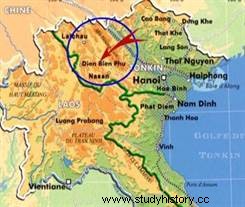 During this march towards Diên Biên Phu, joined by a thousand trucks, the 50,000 porters Vietnamese accomplish a real feat. They prove capable of bringing on bicycles or on the backs of men, and over 300 kilometers of rutted roads and paths, pieces of heavy artillery (elements of anti-aircraft batteries, 120 mortars, 105 guns) and all the necessary logistics for the troops. Some bikes will carry up to 200 kg load!
During this march towards Diên Biên Phu, joined by a thousand trucks, the 50,000 porters Vietnamese accomplish a real feat. They prove capable of bringing on bicycles or on the backs of men, and over 300 kilometers of rutted roads and paths, pieces of heavy artillery (elements of anti-aircraft batteries, 120 mortars, 105 guns) and all the necessary logistics for the troops. Some bikes will carry up to 200 kg load!
At the beginning of 1954, Ciap divisions arrived in the sector. The French intelligence services confirm the presence of nearly 60,000 men equipped with significant artillery, such as twenty 105 howitzers, fifteen 75 cannons and numerous mortars and recoilless guns.
The French found themselves surrounded and had to request emergency reinforcements, the expeditionary force increasing to nearly 12,000 men... Originally offensive, their plan of action becomes defensive. However, the French remain convinced that the enemy cannot deploy its artillery pieces on the heights surrounding the camp and that no shell can, therefore, accurately hit sensitive points such as, for example, the terrain of aviation in the center of the camp.
Fierce fighting and fall of Diên Biên Phu
In mid-January, we believed an attack was imminent, but General Giap finally sent some of his troops to Laos, where the Viêt- minh launched an offensive. On the contrary, Giap began a long, organized siege, encircling Diên Biên Phu by 350 kilometers of trenches. On March 13, he ordered his troops to attack. In one week, the Vietnamese reached 200 meters from the camp, while their DCA, equipped with 30 37 mm guns and 50 12.7 mm machine guns, considerably slowed down the French air assets, both for the supply of weapons and in food only for the evacuation of the wounded.
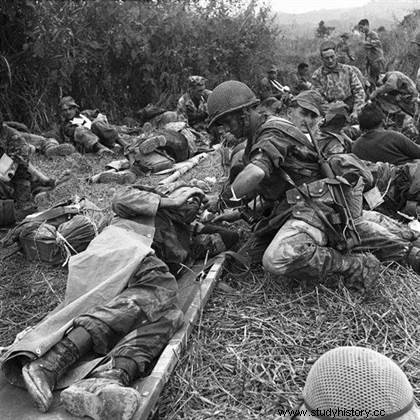 On March 28, the airfield became unusable, the airlift was cut, and supplies did not flow. do more than parachute in extreme conditions for pilots. The camp was pounded by artillery (200,000 shells were fired in less than two months) and the outposts (baptized “Béatrice”, “Gabrielle”, “Isabelle”, etc.) were attacked one after the other. At the end of March, fighting increased in the trenches, where the Viêt-Cong (Viêt-Minh soldiers) were constantly replenished by porters.
On March 28, the airfield became unusable, the airlift was cut, and supplies did not flow. do more than parachute in extreme conditions for pilots. The camp was pounded by artillery (200,000 shells were fired in less than two months) and the outposts (baptized “Béatrice”, “Gabrielle”, “Isabelle”, etc.) were attacked one after the other. At the end of March, fighting increased in the trenches, where the Viêt-Cong (Viêt-Minh soldiers) were constantly replenished by porters.
In April, when the seasonal rains began which transformed the theater of operations into a quagmire, there were now a thousand wounded in the French camp who could not be evacuated. The last hope lies in the talks taking place at the same time between the Western and Communist powers on the future of Korea and Vietnam. We are waiting for the opening of the Geneva conference. However, this will come too late for the soldiers of Diên Biên Phu...
While the noose had tightened considerably, the camp having been reduced to 1 km2, and most of the forts had been taken in the first days of May, the assault final launches on May 7. The 5,500 men of the entrenched camp who were still able-bodied fought under a deluge of artillery. The ceasefire was declared at 5:30 p.m., after Vietnamese soldiers took over the command post of the French leader de Castries, general since mid-March.
As these terrible 56 days of siege come to an end, the toll is heavy:the Viet Minh lost 8,000 men and counted 15,000 wounded; the French deplore 1,700 killed and 1,606 missing, also counting 4,500 wounded. 10,000 men are taken prisoner in camps. The mistreatment inflicted on them only allowed a third of them to come out alive when they were released in September 1954.
Peace agreements
The day after the French defeat, on March 8, the international conference finally opened in Geneva in order to end the war in Indochina, to formalize the departure of the French settlers and to recognize the independence of Vietnam. This conference, which brings together representatives of some twenty nations including France, the United States, Great Britain, the USSR and China, has set itself the objective of finding a solution before July 20 at midnight. , deadline for the conduct of negotiations.
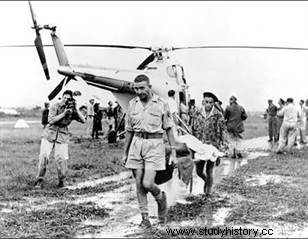 The agreements reached during the conference were formalized and signed the next day, July 21, 1954. In addition to confirming the cease -fire throughout French Indochina for the following days, the French government undertakes to quickly evacuate its troops, while the Viet Minh releases French prisoners and withdraws from Laos and Cambodia. But above all, Vietnam, which has become independent, must be divided on either side of the 17th parallel. Free elections are scheduled for 1956 for the reunification of the country.
The agreements reached during the conference were formalized and signed the next day, July 21, 1954. In addition to confirming the cease -fire throughout French Indochina for the following days, the French government undertakes to quickly evacuate its troops, while the Viet Minh releases French prisoners and withdraws from Laos and Cambodia. But above all, Vietnam, which has become independent, must be divided on either side of the 17th parallel. Free elections are scheduled for 1956 for the reunification of the country.
The Viet Minh, which is in the part of Vietnam north of the 17th parallel, proclaims the Democratic Republic of Vietnam. Its capital is Hanoi and its communist regime is led by Ho Chi Minh. As for the southern part of Vietnam, also set up as an independent state, it is ruled by an emperor won over to the West, Bao Dai. This one will be reversed quickly by Ngô Dinh Dîem, an anti-communist nationalist supported by Washington. Free elections will never take place and, ten years after the end of the Indochina war, the Vietnam war begins, bringing face to face the fighters of the communist North and those of the South supported by the Americans.
Bibliography
- Diên Biên Phu:November 20, 1953 – May 7, 1954, by Pierre Pellissier. Tempus, 2014.
- Diên Biên Phu:March 13 - May 7, 1954, by Ivan Cadeau. Tallandier, 2013.
- Jacques Valette, The Indochina War, 1945-1954, Armand Colin, 1994.
To go further
- The 317th section, by Pierre Schcendoerffer. Studiocanal, 2008.
